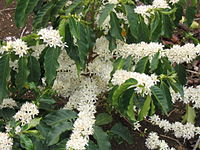
Photo from wikipedia
Arabica and robusta are two major coffee beans being sold worldwide. It is well recognized that coffee quality is influenced by their origin and the microbiological activities that drive their… Click to show full abstract
Arabica and robusta are two major coffee beans being sold worldwide. It is well recognized that coffee quality is influenced by their origin and the microbiological activities that drive their fermentation. However, in many coffee plantations information about the natural diversity of bacteria that inhabit the arabica and robusta coffee cherries is limited. Here, we sampled arabica and robusta coffee cherries from Malang, East Java, Indonesia, then sequenced and analysed their bacterial composition. We found that: (a) arabica cherries contained bacteria with less diversity and abundance compared with robusta; (b) both coffee cherries were heavily populated by extremophiles, presumably dispersed from volcanic activities; (c) groups known to be involved in coffee fermentation such as lactic acid bacteria, acetic acid bacteria, Enterobacteria, and soil-associated bacteria were present in both arabica and robusta coffee cherries, and (d) arabica cherries were dominated by Leuconostoc pseudomesenteroides. These findings highlight that coffee cherry bacteria are highly diverse, the majority of which might come from the environment, with some potentially beneficial or detrimental to coffee quality. Knowledge of the natural microbial diversity of coffee cherries may be useful for the development of coffee fermentation technologies to yield coffee beans with consistent quality.
Journal Title: FEMS microbiology letters
Year Published: 2023
Link to full text (if available)
Share on Social Media: Sign Up to like & get
recommendations!